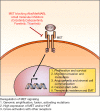MET: roles in epithelial-mesenchymal transition and cancer stemness
- PMID: 28164090
- PMCID: PMC5253283
- DOI: 10.21037/atm.2016.12.67
MET: roles in epithelial-mesenchymal transition and cancer stemness
Abstract
In a number of cancers, deregulated MET pathway leads to aberrantly activated proliferative and invasive signaling programs that promote malignant transformation, cell motility and migration, angiogenesis, survival in hypoxia, and invasion. A better understanding of oncogenic MET signaling will help us to discover effective therapeutic approaches and to identify which tumors are likely to respond to MET-targeted cancer therapy. In this review, we will summarize the roles of MET signaling in cancer, with particular focus on epithelial-mesenchymal transition (EMT) and cancer stemness. Then, we will provide update on MET targeting agents and discuss the challenges that should be overcome for the development of an effective therapy.
Keywords: MET; cancer stem cell (CSC); epithelial-mesenchymal transition (EMT).
Conflict of interest statement
The authors have no conflicts of interest to declare.
Figures

Similar articles
-
Update on Epithelial-Mesenchymal Plasticity in Cancer Progression.Annu Rev Pathol. 2024 Jan 24;19:133-156. doi: 10.1146/annurev-pathmechdis-051222-122423. Epub 2023 Sep 27. Annu Rev Pathol. 2024. PMID: 37758242 Free PMC article. Review.
-
Induction of metastasis, cancer stem cell phenotype, and oncogenic metabolism in cancer cells by ionizing radiation.Mol Cancer. 2017 Jan 30;16(1):10. doi: 10.1186/s12943-016-0577-4. Mol Cancer. 2017. PMID: 28137309 Free PMC article. Review.
-
Reprogramming during epithelial to mesenchymal transition under the control of TGFβ.Cell Adh Migr. 2015;9(3):233-46. doi: 10.4161/19336918.2014.983794. Epub 2014 Nov 17. Cell Adh Migr. 2015. PMID: 25482613 Free PMC article. Review.
-
Targeting met mediated epithelial-mesenchymal transition in the treatment of breast cancer.Clin Transl Med. 2014 Dec;3(1):30. doi: 10.1186/s40169-014-0030-5. Epub 2014 Sep 26. Clin Transl Med. 2014. PMID: 26932375 Free PMC article.
-
MiR-206 inhibits HGF-induced epithelial-mesenchymal transition and angiogenesis in non-small cell lung cancer via c-Met /PI3k/Akt/mTOR pathway.Oncotarget. 2016 Apr 5;7(14):18247-61. doi: 10.18632/oncotarget.7570. Oncotarget. 2016. PMID: 26919096 Free PMC article.
Cited by
-
Resistance to Anti-angiogenic Therapies: A Mechanism Depending on the Time of Exposure to the Drugs.Front Cell Dev Biol. 2020 Jul 7;8:584. doi: 10.3389/fcell.2020.00584. eCollection 2020. Front Cell Dev Biol. 2020. PMID: 32775327 Free PMC article. Review.
-
Efficacy of Savolitinib vs Sunitinib in Patients With MET-Driven Papillary Renal Cell Carcinoma: The SAVOIR Phase 3 Randomized Clinical Trial.JAMA Oncol. 2020 Aug 1;6(8):1247-1255. doi: 10.1001/jamaoncol.2020.2218. JAMA Oncol. 2020. PMID: 32469384 Free PMC article. Clinical Trial.
-
MicroRNA in Lung Cancer Metastasis.Cancers (Basel). 2019 Feb 23;11(2):265. doi: 10.3390/cancers11020265. Cancers (Basel). 2019. PMID: 30813457 Free PMC article. Review.
-
Widespread activation and critical role of EMT and stemness in the neuroendocrine differentiation of prostate cancer (Review).Oncol Rep. 2025 Sep;54(3):109. doi: 10.3892/or.2025.8942. Epub 2025 Jul 11. Oncol Rep. 2025. PMID: 40641143 Free PMC article. Review.
-
Structural and Functional Insight Into the Glycosylation Impact Upon the HGF/c-Met Signaling Pathway.Front Cell Dev Biol. 2020 Jun 18;8:490. doi: 10.3389/fcell.2020.00490. eCollection 2020. Front Cell Dev Biol. 2020. PMID: 32626713 Free PMC article. Review.
References
Publication types
Grants and funding
LinkOut - more resources
Full Text Sources
Other Literature Sources
Miscellaneous
